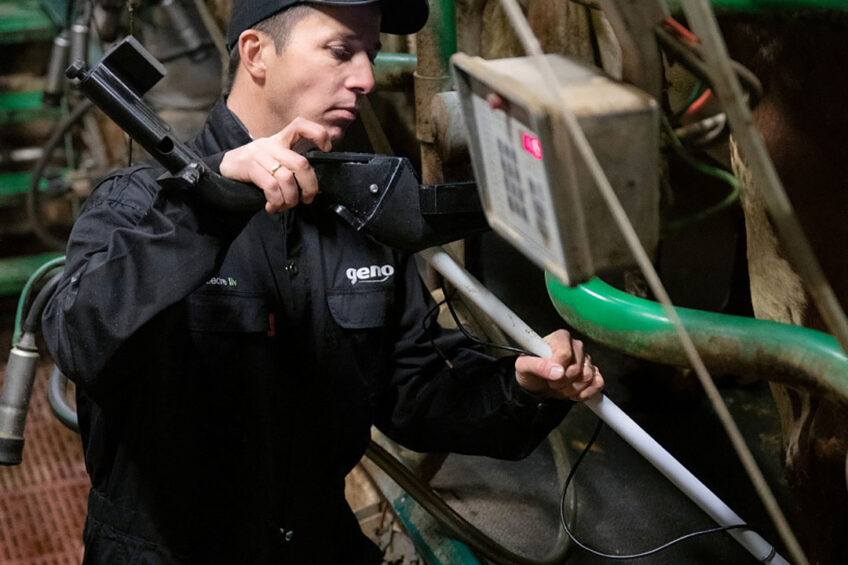High tech udder scanner for more precise data

Norwegian cattle breeding organisation Geno is trialing new scanning technology as part of a research project that will enable it to collect more comprehensive and precise data on udder traits.
This will be used in its breeding programs and accelerate the progress made in improving functionality, health and welfare traits within Norwegian Red cattle, according to a news release.

The scanning system includes a newly developed hand-held 3D camera, which is mounted on a sturdy pole together with a small computer. “The camera is placed on the floor underneath the cow’s udder and makes it possible to take images of the teats and the udder from a ‘bottom up’ perspective,” says Geno researcher Øyvind Nordbø, who is based at the co-operative’s main office in Hamar, in Norway.
“The operator is able to see the image on the computer screen and record it alongside the animal’s ID.”
Accuracy
This camera records pictures and data of the cow’s udder within a few millimeters of accuracy and the images can be used to build a 3D digital model.
The project, which uses this advanced scanning technology, is being carried out by Geno in collaboration with the Norwegian pig and beef breeding organizations, Norway’s University of Life Science and Technology and the University of Auckland, with support from the Norwegian Research Council.
“If we succeed with this, we will be able to replace traditional visual scoring systems with a digital system”
The initial trial, which started in September 2019 and will run until the end of April 2020, is using the new camera technology to scan around 1,500 cows in Norway. Technicians will also score cows visually and this data will be used, along with the scanned images in computer systems, to build up algorithms through advanced machine learning.
“These results will improve our accuracy in predicting udder traits within our breeding programs,” adds Nordbø.
“We will also store the images for future research, allowing us to develop new traits for animal breeding. And looking ahead, we hope to develop additional camera systems that can make high quality 3D images of cows’ legs and the bodies.
Replace traditional visual scoring
“If we succeed with this, we will be able to replace traditional visual scoring systems with a digital system based on 3D imaging techniques.”
The technician scoring system has worked well in the Geno breeding programs for many years and has provided good data for developing health and functionality traits, as well as production traits.

“But the more precise data that will be available from the scanners will accelerate our progress and give the Norwegian Red breeding program a clear advantage.”
Geno is putting emphasis on traits that will breed cows to meet the changing demands of its farmers in Norway and in its international markets.
“Many want to breed cows with uniform udders and teat placement that are more suited to robotic milking machines. Udder and teat characteristics are also linked to cow health, welfare and sustainability, which emphasises the importance of genetic improvements in these areas,” says Nordbø.
Also read: Innovations dairy farmers should know about
Breeding better cows
Norwegian Red cows are well-known for their high health and fertility characteristics, thanks to the selection pressure placed on these traits during the past 30 years. “Other breeds, particularly the Holstein, have been compromised in the pursuit of higher production.”
“Norwegian Red genetics are frequently used in breeding programs across the world to restore and improve these key functional traits. More detailed data, which will be available from this new technology, offers our farmers opportunities to breed better cows for their systems and to improve the sustainability and efficiency of their units, in Norway and in herds internationally,” he adds.
For more info: Geno
Join 13,000+ subscribers
Subscribe to our newsletter to stay updated about all the need-to-know content in the dairy sector, two times a week.










